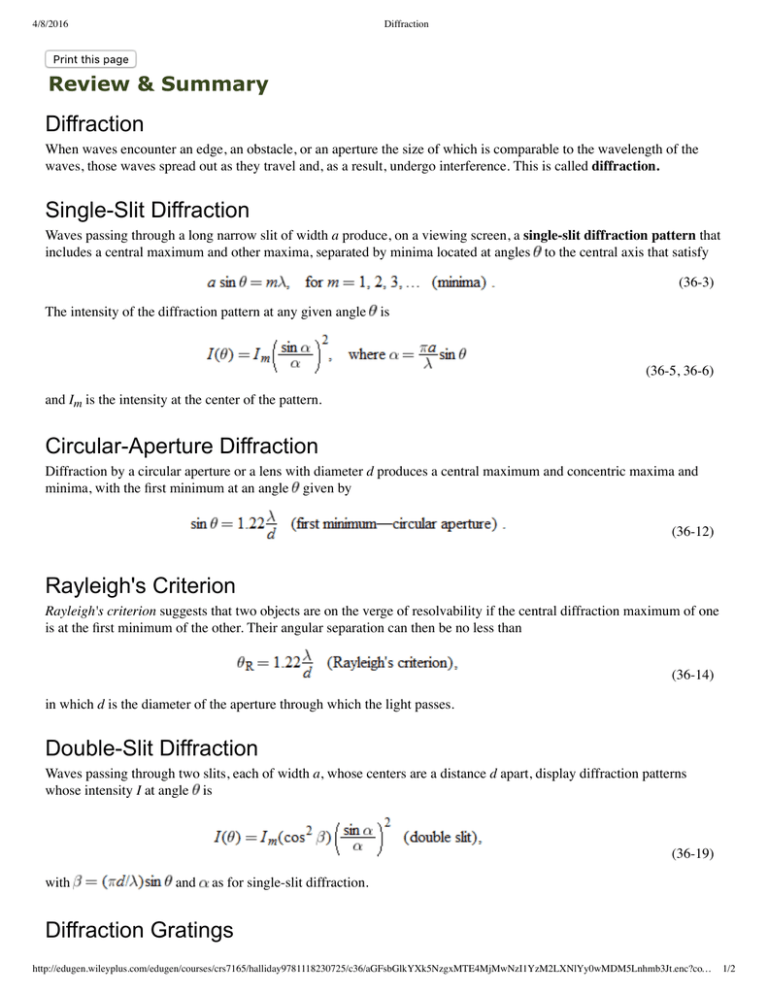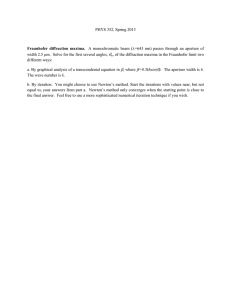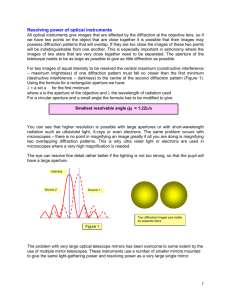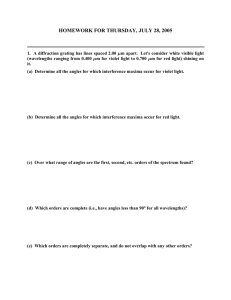Diffraction Review & Summary
advertisement

4/8/2016 Diffraction Review & Summary Diffraction When waves encounter an edge, an obstacle, or an aperture the size of which is comparable to the wavelength of the waves, those waves spread out as they travel and, as a result, undergo interference. This is called diffraction. Single­Slit Diffraction Waves passing through a long narrow slit of width a produce, on a viewing screen, a single-slit diffraction pattern that includes a central maximum and other maxima, separated by minima located at angles to the central axis that satisfy (36-3) The intensity of the diffraction pattern at any given angle is (36-5, 36-6) and Im is the intensity at the center of the pattern. Circular­Aperture Diffraction Diffraction by a circular aperture or a lens with diameter d produces a central maximum and concentric maxima and minima, with the first minimum at an angle given by (36-12) Rayleigh's Criterion Rayleigh's criterion suggests that two objects are on the verge of resolvability if the central diffraction maximum of one is at the first minimum of the other. Their angular separation can then be no less than (36-14) in which d is the diameter of the aperture through which the light passes. Double­Slit Diffraction Waves passing through two slits, each of width a, whose centers are a distance d apart, display diffraction patterns whose intensity I at angle is (36-19) with and as for single-slit diffraction. Diffraction Gratings http://edugen.wileyplus.com/edugen/courses/crs7165/halliday9781118230725/c36/aGFsbGlkYXk5NzgxMTE4MjMwNzI1YzM2LXNlYy0wMDM5Lnhmb3Jt.enc?co… 1/2 4/8/2016 Diffraction A diffraction grating is a series of “slits” used to separate an incident wave into its component wavelengths by separating and displaying their diffraction maxima. Diffraction by N (multiple) slits results in maxima (lines) at angles such that (36-25) with the half-widths of the lines given by (36-28) The dispersion D and resolving power R are given by (36-29, 36-30) and (36-31, 36-32) X­Ray Diffraction The regular array of atoms in a crystal is a three-dimensional diffraction grating for short-wavelength waves such as x rays. For analysis purposes, the atoms can be visualized as being arranged in planes with characteristic interplanar spacing d. Diffraction maxima (due to constructive interference) occur if the incident direction of the wave, measured from the surfaces of these planes, and the wavelength of the radiation satisfy Bragg's law: (36-34) Copyright © 2014 John Wiley & Sons, Inc. All rights reserved. http://edugen.wileyplus.com/edugen/courses/crs7165/halliday9781118230725/c36/aGFsbGlkYXk5NzgxMTE4MjMwNzI1YzM2LXNlYy0wMDM5Lnhmb3Jt.enc?co… 2/2








